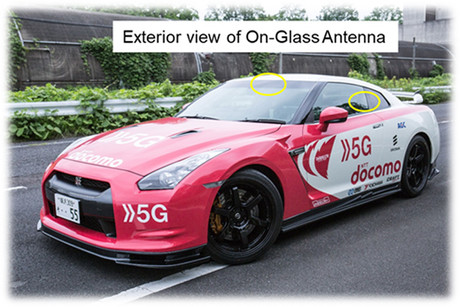NTT DOCOMO trials 5G in high-speed car

The world’s first 28 GHz band compatible antenna has reached speeds of 8 Gbps in a 5G connected car.
The trial used a vehicle glass-mounted antenna and was undertaken by NTT DOCOMO and Ericsson Japan.
The 5G 28 GHz band compatible on-glass antennas used in the field trial were designed and developed by AGC. The antennas are not easily seen from the exterior and can be installed on glass surfaces without affecting the vehicle design.
Radio waves in the 28 GHz band have a large propagation loss and have difficulty propagating over long distances. By installing an on-glass antenna on the vehicle, radio waves above 6 GHz can be transmitted and received using the ‘beamforming function’, which concentrates radio waves in a specific direction, and the ‘MIMO function’, which improves communication speed by simultaneously transmitting different data from multiple antennas. This allows stable, high-speed communications even for vehicles in operation.
For this field trial, 5G high-speed communications using both the beamforming function and the MIMO function was performed with a vehicle equipped with on-glass antennas. The trial was held at the National Institute for Land and Infrastructure Management in Ibaraki Prefecture, Japan. While moving at high speeds of approximately 100 km/h, a maximum communication speed of 8 Gbps was achieved, and a maximum of 11 Gbps was achieved at a speed of approximately 30 km/h, confirming that high-speed in-vehicle communications in the 28 GHz band can be achieved by utilising on-glass antennas.
DOCOMO, AGC and Ericsson Japan will continue working towards utilising 5G in various environments including in-vehicle communication modules, aiming to see 5G connected cars become a reality.
The trial was carried out at a straight section of test course approximately 2.2 km long at the National Institute for Land and Infrastructure Management. 5G data communications were carried out using the 28 GHz band between the moving test vehicle equipped with a 5G mobile station to which several on-glass antennas were connected and three 5G base stations set up along the sides of the course.
For this trial, a total of eight on-glass antenna elements were installed in the test vehicle on the windshield, both side windows and the rear window, so that radio waves could be received from various directions.
By utilising the on-glass antennas to receive signals in combination with the MIMO function and the beamforming function with up to four beams supporting vertical and horizontal polarisation, 5G high-speed communications were realised, with up to 8 Gbps at a moving speed of approximately 100 km/h and 11 Gbps at a moving speed of approximately 30 km/h.
Please follow us and share on Twitter and Facebook. You can also subscribe for FREE to our weekly newsletter and bimonthly magazine.
Advanced Navigation develops navigation system for rocket
The system is supporting Gold Coast-based Gilmour Space Technologies in the imminent launch of...
GPS alternative for drones uses visual data from stars
Remote sensing engineers have combined celestial navigation with vision-based technology to...
Robotics facility to manufacture AI navigation systems
The facility will scale up the manufacturing of Advanced Navigation's AI navigation systems...





